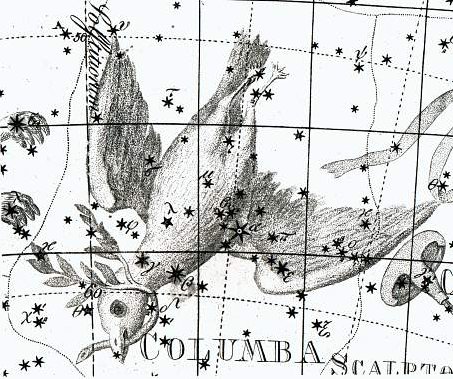|
5. In the 6th right ascension hour the rule of Sun changes to a rule of Moon. The Hare has 'landed' and the season of reproduction has arrived. Sun is moving to the southwest, flying down, and instead of a great star there is a black hole where his eye should have been:
The illustration of Bode has the Belly of the Sun Bird in full view, not the back side as in Urania's Mirror. At the highest point of Sun's path he must turn around and dive. On the Marquesas noon was named 'the belly of the sun': "The Polynesians mingle the time-indications based on the position of the sun with others which are derived from the life of men and nature. We are told that the Hawaiian day was divided into three general parts, 1, breaking the shadows, 2, the plain, full day, 3, the decline of the day ... The lapse of night, however, was noted by five stations: 1, about sunset; 2, between sunset and midnight; 3, midnight; 4, between midnight and sunrise; 5, sunrise. A native Hawaiian [Malo] writes: - 'When the stars fade away and disappear, it is ao, daylight; when the sun rises, day has come, la; when the sun becomes warm, morning is past; when the sun is directly overhead it is awahea, noon; when the sun inclines to the west in the afternoon, the expression is wa ani ka la. After that come evening, ahi-ahi (ahi, fire), and then sunset, napoo ka la, and then comes po, the night, and the stars shine out ..." "In Tahiti the day has six divisions which are fairly accurately determined by the height of the sun. Names are given for midnight, midnight to daybreak, daybreak, sunrise, the time when the sun begins to be hot, when it reaches the meridian, evening before sunset, the time after sunset." "For the Marquesas are given: - daybreak, twilight, dawn, ('the day or the red sky, the fleeing night'), broad day - bright day from full morning to about ten o'clock -, noon ('belly of the sun'), afternoon ('back part of the sun'), evening ('fire-fire', the same expression as in Hawaii, i.e. the time to light the fires on the mountains or the kitchen fire for supper)." (Martin P. Nilsson, Primitive Time-Reckoning.) We can guess that λ and γ illustrate how the eye of Sun disappears respectively how instead a pair of Moon ears are arriving. In the sky roof the 6th hour stretches from day number 5 / 24 * 365¼ = 76 to day number 6 / 24 * 365¼ = 91. In the G text the 6th hour seems to begin with glyph number 408 + 76 + 1 = 485 and to end with glyph number 408 + 91 = 499, i.e. with 15 glyphs:
|
||||||||||||||||||||||||||||||||||||||||||||||||||||||||||||||||||





